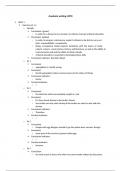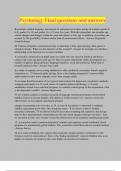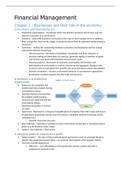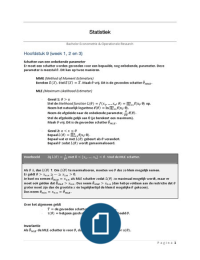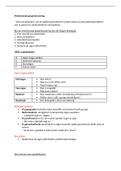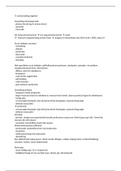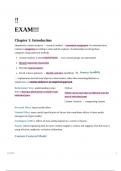Summary written by Saskia Kriege
Cognitive Science and Artificial Intelligence
,Lecture 2 – Theoretical Concepts
Artificial Intelligence =
The study of intelligent behaviour achieved
through computational means.
AI is about problem solving by means of computational methods able to derive insight
from data
Thinking =
A process that occurs in the human brain over time.
Some claim it is a computational process → controversial idea
➔ Can machines really think?
(if we accept the hypothesis that thinking is a computational process, then answer
would be yes)
Alan Turing =
1912-1954, father of AI
Cracking intercepted coded messages that enabled Allies to defeat Nazis.
Turing Test (1950), test of a machine’s ability to exhibit intelligent behaviour
equivalent to, or indistinguishable from, that of a human.
He proposed that a human evaluator would judge natural language conversations
between a human and a machine designed to generate human-like responses.
Knowledge =
The understanding about a certain domain, which is often expressed in terms of facts
Knowledge comes from
- human beings → experience/education → experts in given domain
- historical data → collected observations, patterns → analysed properly
generates new knowledge
,Knowledge base =
Collection of symbolic structures describing the problem domain with a specific
granularity degree. Knowledge structures are believed to be the ultimate truth about
the problem being modelled.
Granularity = the level of detail in a set of data
Knowledge-based system =
Intelligent reasoning system that relies on the KB to derive new knowledge to solve a
problem.
Intelligent systems always rely on knowledge, explicit KB to learn from, or implicit
(directly programmed).
Representation =
Process of encoding abstract ideas by means of tangible systems
Gottfried von Leibniz =
1646-1716, inventor in field of mechanical calculators and refined binary number
system.
- We don’t operate abstract entities but the symbolic representations of these
entities → ‘fourteen’ can be 14, XIV, or 1110
- Idea may be abstract, but symbols are concrete, so would be enough to define
rules to manipulate these symbols and generate new ideas in form of symbols
Rules of arithmetic allow dealing with abstract numbers in terms of concrete
symbols, so the manipulation of those symbols reflects the relations among the
numbers.
Rules of logic allow dealing with abstract ideas in terms of concrete symbols, so the
manipulation of those symbols mirrors the relations among the ideas.
→ Human thoughts are formless and abstract, but we can still deal with them
concretely as a kind of arithmetic, by representing them symbolically and operating
on the symbols.
Symbolic representations =
Needs to represent problem domain by using knowledge from experts and data
resources. And needs to express this emerging knowledge (inner knowledge the
systems learns to solve and knowledge it returns).
→ intelligent systems should produce same outcome regardless of the symbols used
to represent the input knowledge
An intelligent system has a different level of granularity than humans (chess).
Reasoning =
Formal manipulation of the symbols representing a collection of propositions to
produce representations of new ones.
, Propositions =
Considered to hold/not hold
Propositional attitudes =
Various relationships between people and propositions
Related to each other in certain ways (evidence/contradict)
Sentences =
Symbolic representations of propositions
Sentences are the things people say, propositions are the things either true/false
Same propositional content can be expressed in different sentences
Proposition is the part of a sentence that is constant (so true/false)
Logical entailment =
S1, S2,…, Sn logically entails S if the truth of S is implicit in the truth of Si.
Don’t need to know what symbols mean, just the truth value.
Allows to reason with propositions
Reasoning is needed:
Limited knowledge in a problem domain, reasoning allows to derive missing pieces of
knowledge from pieces we have represented in KB.
Symbolic Artificial Intelligence = Good Old-Fashioned AI
Attempts to solve a given problem by exploiting explicit, symbolic knowledge
representations
Sub-Symbolic Artificial Intelligence =
Also attempts to solve the problem while learning internal knowledge
representations from data.
Sub-symbolic models to predict outcome of unseen problem instances:
Tree-based decision model →
statistical measures, tree from data → tree representing inner knowledge discovered
from data
Neural networks → connectionism
internal knowledge encoded into weights connecting one neuron/node to another →
black box
Even if you disagree with the idea that numbers are also symbolic representations of
a numerical abstract quantity, reasoning is always behind intelligent systems.
Machine Learning → interpretability, accuracy
Black boxes are very accurate in terms of the predictions they make. But they often
learn complex representations.
White boxes are less accurate in terms of the predictions they make. But they often
learn simpler representations.



